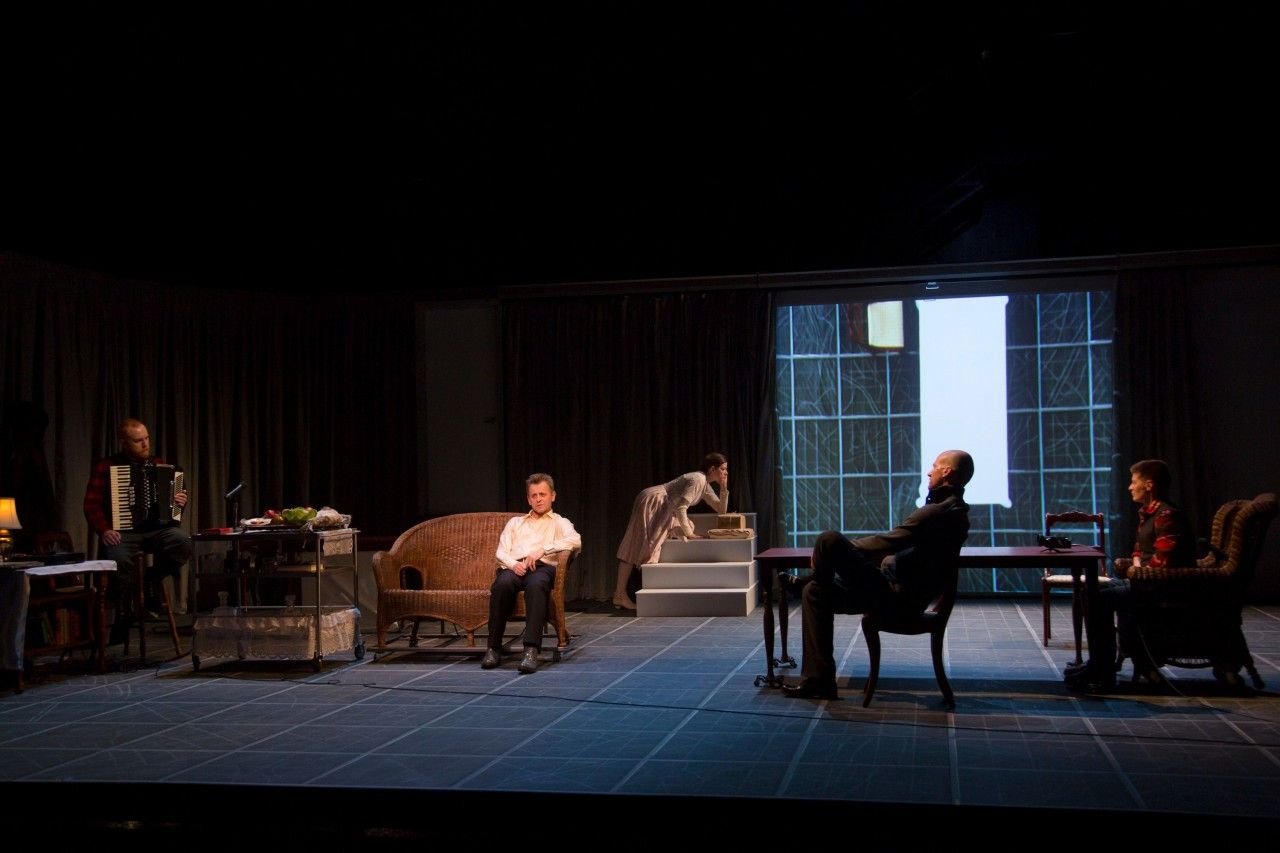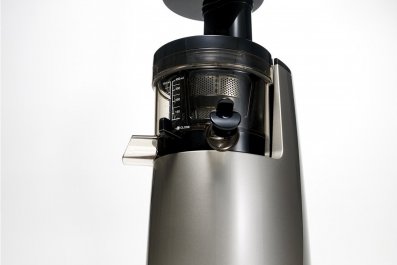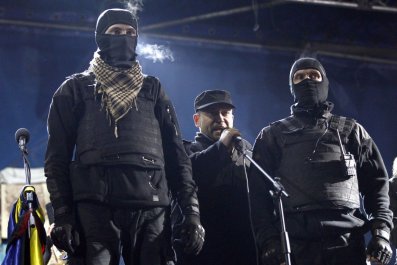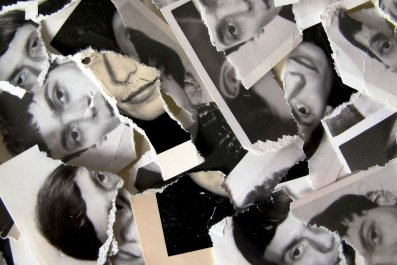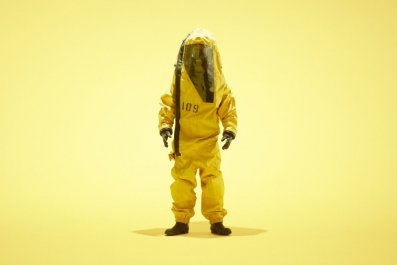A gaggle of women are waiting for Mikhail Baryshnikov outside of Berkeley Rep Theater in California, a common enough sight on Broadway, where fans queue up for an autograph from a famous actor, but something of a rarity here in what Chekhov might have called the provinces. They vary in age from late-middle—those women who first made the dancer's acquaintance in The Turning Point (1977), or saw him live, touring with the American Ballet Theater in the 1970s and 1980s—to a younger contingent who found him through Sex and the City, where he played one of Carrie Bradshaw's suitors. They just saw him perform, if not quite dance, in Man in a Case, Big Dance Theater's somewhat experimental production of several Chekhov stories, and if they were disappointed that he didn't fly through the air with the greatest of ease, they're not showing it.
"I get a lot of letters from college students who say they saw me in Sex and the City and then saw some videos, read some books or something," says Baryshnikov over breakfast a few weeks later. "They're getting interested backwards—they saw The Nutcracker [his legendary ABT production with then-partner Gelsey Kirkland] on YouTube, and it begins; I'm flattered."
It was 40 years ago this summer that the then 26-year-old star of the Kirov Ballet was touring in Toronto, already drawing crowds, when he told his KGB handlers he was going to sign some autographs—and then gave them the slip, and sought political asylum in Canada before becoming a citizen of the United States.
"When I left Russia, it was in a Neanderthal state of modern art," he says between bites of his breakfast: whole-wheat toast. (Note, gentleman: If you want to look like that, you have to eat like that.) "I had been working in a very conservative theater. I wanted to expand and at least meet some people, speak different languages, and see how I could stretch myself as a dancer." What he found when he made it to New York was a world of innovative dance, and there he worked with Jerome Robbins, Alvin Ailey, Twyla Tharp and, most notably, George Balanchine at the New York City Ballet. (Though a Russian, Balanchine is often called the father of American ballet.)
"As a choreographer, to work with him means working with a whole body of history," says Annie-B Parson, who choreographed (and co-directed, with her husband Paul Lazar) Man in a Case. "Because of the nature of the medium, we don't know the Picassos of dance—Balanchine, Cunningham. Working with him is like working with 50 years of dance history."
Though the Brooklyn-based Big Dance Theater draws a lot on literary sources, the results are what might be described as nonlinear—or, as one woman at the Berkeley Rep performance put it, "What the hell?" When Baryshnikov asked them to develop a work for him based on the stories "The Man in the Case" and "About Love," she was puzzled. "I read for dance," she says, "and he plays this character who wouldn't dance."
Baryshnikov's main character, a schoolteacher name Byelikov, is socially phobic to the point of paranoia. His refusal to join in life's dance and marry the woman who tries to pull him out of his case is the source of the story's tragedy and the beginning of the artist's involvement. "No matter if you're happily married, you see somebody and"—a sharp intake of breath—"you start losing oxygen," he says. "I am in my 60s, and very happily married [to ABT ballerina Lisa Rinehart], and I'm afraid to fall in love with somebody. What a pain in the butt it would be for everybody! But here, he's a single guy...." Which brings him to what may be Chekhov's central message: "Grab this feeling, no matter what."
The no-dancing thing becomes sort of a joke. "He's afraid to make a step," he says of Byelikov. "He's very comfortable in his cell. He sits with his galoshes, he has his books, his little radio. God forbid that he should have to share his bed with this voluptuous and very liberal woman!" (Late in the show, playing another character, Baryshnikov breaks into a little soft-shoe, ending his pas d' un with a shrug and a tossed-off line—"Well, you asked for it!" Sort of an inside joke, says Parson. "Audiences and some critics seem to forget that time wears away the body," she says. "They expect him to do things he did 30 years ago.")
"I was interested in this character because, if anything, I am opposite myself," says Baryshnikov in his still slightly fractured English. "I'm a liberal; this guy is almost a fascist. He's against women's emancipation, any progressive thing. It reminds me of American Congress."
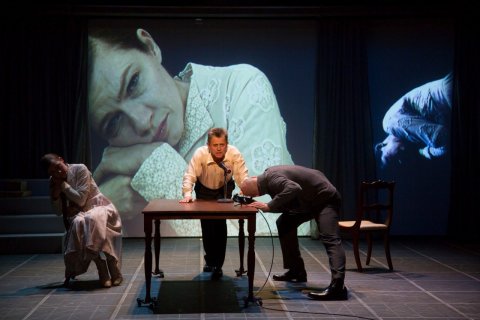
Defecting as he did at the height of the Cold War, Baryshnikov was courted by the American Right. "I was groomed to be a Republican," he says. "It didn't work out." He does, though, list a number of wealthy conservatives among his closest friends. Donald Kendall, the past president of PepsiCo, was photographed next to Nixon at the Kitchen Debate with Khrushchev in 1959 (one of those Holy Grail moments for anti-Communists). When Baryshnikov put a million of his own dollars toward establishing the Baryshnikov Arts Center in 2005, Kendall called and said, "I'm matching it."
"That's a mensch," says the dancer.
Baryshnikov's political differences with conservatives are more about art, perhaps. "Conservatives always look for some crime in an art form," he says, "because in an art form [the meaning] is not really on the surface. It's hidden."
And he bristles at the idea that he is new to acting. "People say, 'Oh, now you do theater!' I did theater in the 1980s. It was not 100 percent successful, but I did Metamorphosis [on Broadway] and four short Beckett plays with [Mabou Mines founder] JoAnne Akalaitis. I have done already enough plays that for some actors is a lifetime. I was really lucky that a lot of doors were open for me. Sometimes I jumped without much thinking and would take some little detours for some projects, but you learn from your mistakes."
Our breakfast is interrupted by a call from someone he refers to as his "whisperer"—an acting coach in Hollywood. She hasn't seen Man in a Case yet, but will have a chance when it comes to Santa Monica (after runs in Boston and Chicago). Next Baryshnikov will be touring in The Old Woman, a two-hander (with Willem Dafoe) based on a short story by the Russian surrealist Daniil Kharms (executed by Stalin, of course). The play is directed by avant-garde pioneer Robert Wilson, and it wowed 'em in Paris last year.
"It was very difficult, the process, like everything Bob Wilson does," says Baryshnikov. "We are in white faces, it takes an hour and a half just to put the makeup on." Seeing stills from the play, which looks like an episode of Gumby in Hell, it's hard to imagine what the ladies waiting for an autograph outside the theater would think.
By all accounts, Wilson runs a tight if weird ship: Everything is choreographed down to a nanosecond. Generally, Baryshnikov likes to feel more in charge of things. "I like to produce my own projects," he says. "I really want to know what's happening behind the scenes. I might be a pain in the ass when it comes to details with directors—that's the way I am, it's too late to change. And I am not maybe always 100 percent pleasant to work with." But it's just work, after all—or, as he says, using a Russian expression, "You don't have to christen baby with people you are working with."
This is someone who, after all, was a star pretty much from the moment he joined the Kirov as a teenager, in a country that takes its ballet as seriously as its figure skating. He does not care about Russia hosting the Olympics, and has not been back since he left. "I'm Russian by culture and education, but I lived in Russia for about 10 years because I came from Latvia," he reminds me. "Latvia was occupied for many years by Russia, but the Russians never felt comfortable there."
His father was in the Russian army and it was his mother who exposed him to the arts; he has described the first time he saw a curtain coming up on a ballet as a moment of revelation as a child: Here was a way out. "But we—my parents, myself, even though I grew up there—never felt at home. Never. My mother died there [a suicide]. I felt totally cold-hearted because I knew it was not my place. It never was, it never will be." He's grateful for all that Russia gave him—the education, the love of art and culture—but more grateful for his own agency, to live outside the box.
"I always thought I want to be a man of the world," he says, "and be free."



